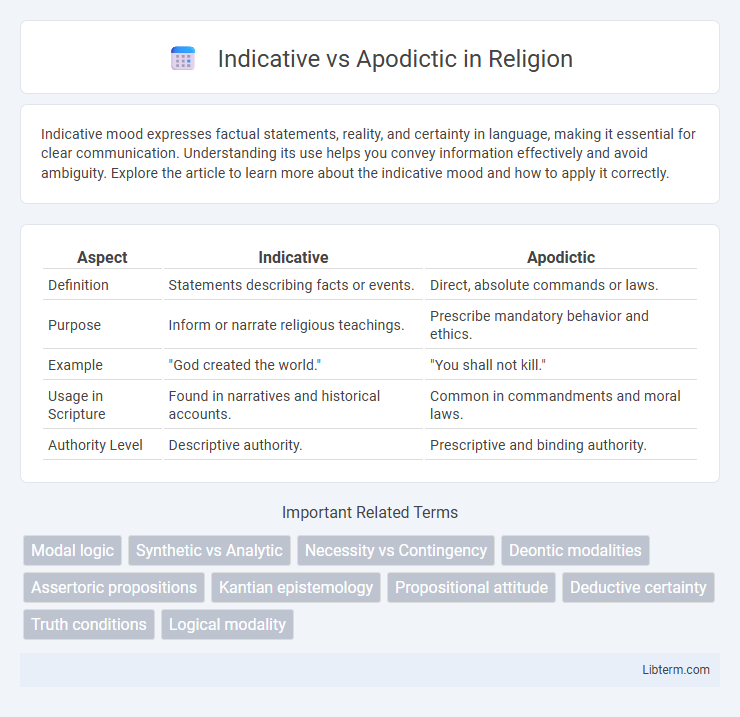Indicative mood expresses factual statements, reality, and certainty in language, making it essential for clear communication. Understanding its use helps you convey information effectively and avoid ambiguity. Explore the article to learn more about the indicative mood and how to apply it correctly.
Table of Comparison
| Aspect | Indicative | Apodictic |
|---|---|---|
| Definition | Statements describing facts or events. | Direct, absolute commands or laws. |
| Purpose | Inform or narrate religious teachings. | Prescribe mandatory behavior and ethics. |
| Example | "God created the world." | "You shall not kill." |
| Usage in Scripture | Found in narratives and historical accounts. | Common in commandments and moral laws. |
| Authority Level | Descriptive authority. | Prescriptive and binding authority. |
Understanding Indicative and Apodictic: Key Definitions
Indicative statements express factual information or observations based on reality, often used to describe what is or what has been. Apodictic statements, in contrast, convey absolute certainty or necessity, presenting truths that are logically or morally indisputable. Understanding the distinction between indicative and apodictic forms is essential for interpreting legal texts, philosophical arguments, and linguistic nuances accurately.
Historical Origins of Indicative and Apodictic Statements
Indicative statements trace their origins to classical Greek philosophy, particularly in Aristotle's works, where they express factual or declarative content about reality. Apodictic statements emerged from ancient legal and ethical traditions, especially within Hebrew biblical texts and early Roman law, denoting authoritative, necessary truths or commands. Their historical development reflects the contrast between describing empirical facts and asserting categorical, incontestable truths.
Core Differences Between Indicative and Apodictic Language
Indicative language expresses factual statements and objective reality, serving to convey information that is verifiable and true under standard conditions. Apodictic language, by contrast, asserts necessary truths or logical certainties that cannot be denied or contradicted, often grounded in moral, legal, or philosophical authority. Core differences lie in their function: indicative language reports what is, whereas apodictic language commands or dictates what must be, reflecting obligation or incontrovertible truth.
Common Uses of Indicative Sentences
Indicative sentences primarily convey factual information, making them essential for statements, descriptions, and questions about reality or certainty. They are commonly used in everyday communication, news reporting, scientific explanations, and historical accounts to express objective truths or ask for verifiable details. This mood contrasts with apodictic sentences, which assert necessity or logical certainty, often found in philosophical or legal contexts.
Examples of Apodictic Statements in Philosophy and Logic
Apodictic statements express propositions that are necessarily true and indisputably certain, often found in formal logic and philosophical discourse. Examples include "All bachelors are unmarried men," illustrating tautological truths, and "A triangle has three sides," a self-evident geometric axiom. In contrast to indicative statements, apodictic judgments serve as foundational premises in deductive reasoning, ensuring validity of conclusions drawn.
Grammatical Features: Indicative vs Apodictic
Indicative mood expresses factual statements, objective reality, or asks questions and is marked by straightforward verb forms reflecting present, past, or future tenses. Apodictic mood, often found in legal or moral texts, issues commands or necessary truths, characterized by verbs in imperative forms or modal auxiliaries that denote obligation or necessity. The distinction lies in the indicative's descriptive function versus the apodictic's prescriptive or axiomatic usage within grammatical structures.
Implications in Legal and Ethical Contexts
Indicative statements describe facts or conditions, forming the basis for evidentiary support in legal proceedings, while apodictic statements assert absolute necessity or certainty, often reflecting ethical mandates or legal imperatives. In legal contexts, the distinction impacts the burden of proof, as indicative claims require validation through evidence, whereas apodictic assertions establish non-negotiable principles guiding judicial decisions. Ethically, apodictic norms dictate moral obligations and prohibitions, influencing legislative frameworks and professional codes of conduct with categorical imperatives.
Indicative and Apodictic in Everyday Communication
Indicative statements convey facts or ask questions based on reality, serving as the foundation for everyday communication by presenting information clearly and objectively. Apodictic statements express absolute certainty or necessity, often used to assert rules or truths that are undeniable within a conversation. Understanding the distinction enhances clarity in dialogue and improves the effectiveness of expressions ranging from casual remarks to formal instructions.
How to Identify Indicative and Apodictic Assertions
Indicative assertions express factual statements or descriptions about reality, often identified by their basis in observable evidence or logical reasoning, such as "The sky is blue." Apodictic assertions convey necessary truths or undeniable principles, recognizable through their inherent necessity and universal validity, exemplified by statements like "All bachelors are unmarried." To distinguish them, examine whether the claim relies on empirical evidence or logical necessity, with indicative assertions being contingent and apodictic ones being absolutely certain.
The Significance of Indicative vs Apodictic in Critical Thinking
The distinction between indicative and apodictic statements plays a crucial role in critical thinking by differentiating between descriptive facts and logically necessary truths. Indicative statements describe empirical observations or conditions, allowing for analysis and evaluation based on evidence and probability. Apodictic statements, representing absolute certainties or self-evident principles, serve as foundational premises in deductive reasoning and rigorous argumentation.
Indicative Infographic

 libterm.com
libterm.com